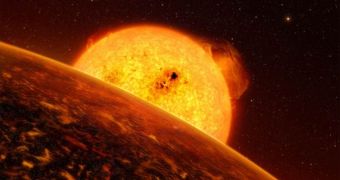Scientists confirmed the existence of the exoplanet CoRoT-7b in October, 2009. The body was found orbiting a nearby star, which is located about 480 light-years away. Measurements at the time determined that the structure had to be rocky, with a solid surface, but new data seem to indicate that the planet may actually be covered in volcanoes. It is also known for experiencing massive temperature variations, and the massive level of volcanic activity might be a direct consequence of this fact, experts announced yesterday at the 215th meeting of the American Astronomical Society (AAS), Space reports.
Early studies of the planet determined that it might be tidally locked to its parent star. This means that it always keeps the same face oriented to the star, similar to the way the Moon always shows the same face, when viewed from the Earth. Other investigations also determined that the day side might be heated to about 2,200 degrees Celsius (4,000 degrees Fahrenheit) at all times, whereas its dark side, the one facing away from the parent star, might be freezing-cold, with temperatures around minus 210 degrees Celsius, or minus 350 degrees Fahrenheit.
According to the team presenting the findings in Washington DC, it could be that CoRoT-7b is a lot more active as far as volcanoes go than Jupiter's moon Io – which, at 400 active volcanoes, is the most active such body in our solar system. “If conditions are what we speculate, then CoRoT-7b could have multiple volcanoes going off continuously and magma flowing all over the surface,” University of Washington in Seattle (UWS) expert Rory Barnes, who presented the team's conclusions, explained. In addition, previous studies also identified other factors that made the planet uninhabitable, such as the fact that its atmosphere might be made of vaporized rock.
This means that, from time to time, these vapors may rain down upon the already fiery surface, making it even more difficult for potential organisms to grab a foothold on the planet. “CoRoT-7b most certainly has no oceans. A planet on a non-circular orbit experiences different amounts of gravitational force at different points along the orbit, feeling the strongest gravitational pull when it is closest to the star and the weakest when it is most distant. As the planet moves between these two points, it stretches and relaxes. This flexing produces friction that heats the interior of the planet resulting in volcanism on the surface,” Barnes concluded.

 14 DAY TRIAL //
14 DAY TRIAL //